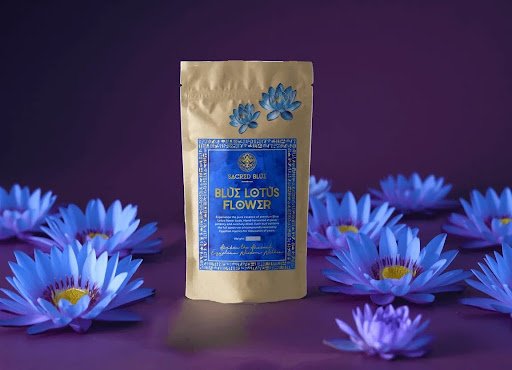Among the rarest and most symbolic blooms known to humankind, the blue lotus flower has captivated civilizations for millennia. Revered in ancient Egypt, India, and parts of Southeast Asia, this mystical flower is far more than just a visual delight—it embodies spiritual awakening, inner peace, and deep-rooted traditions in wellness and ritual.
Today, the popularity of blue lotus flowers is experiencing a beautiful resurgence, especially among those seeking a natural path to meditation, relaxation, and conscious living. With their striking indigo-blue petals and a scent that’s both hypnotic and calming, blue lotus flowers are often used in teas, oils, baths, and ceremonial rituals. But to truly appreciate the essence of this sacred flower, it’s important to understand its rich history, benefits, and versatile applications in modern holistic lifestyles.
A Flower of Divine Symbolism
The blue lotus—scientifically known as Nymphaea caerulea—holds immense spiritual value across various ancient cultures. In Egyptian mythology, it was considered the flower of the sun god Ra and symbolized rebirth and creation. Hieroglyphs and temple paintings often show the flower blooming with the sunrise, linking it to the cyclical nature of life, death, and spiritual awakening.
In Indian traditions, although the blue lotus is less prevalent than the pink variant (Nelumbo nucifera), it still resonates within Hindu and Buddhist philosophies as a symbol of wisdom, serenity, and transcendence.
Natural Relaxant and Consciousness Enhancer
Modern herbalists and wellness seekers are rediscovering the blue lotus for its subtle psychoactive and calming effects. When steeped into a tea or infused into oils and tinctures, the flower offers a gentle euphoric experience. It doesn’t induce hallucinations but promotes a feeling of centeredness, slight sedation, and dream-like clarity.
These effects make blue lotus particularly appealing to those engaging in meditation, yoga, and other forms of mindful practice. It serves as a natural aid for relieving anxiety, enhancing intuition, and promoting emotional healing.
Blue Lotus Tea: A Ritual in Itself
Blue lotus tea is one of the most traditional ways to consume the flower. Its preparation is simple but meditative: dried petals steeped in hot water for 5–10 minutes release a golden infusion that calms the nerves and invites the mind into a peaceful state.
Many describe the experience as deeply tranquil yet mentally alert—perfect for journaling, self-reflection, or simply disconnecting from the digital world. For centuries, this practice has been regarded not just as a beverage, but as a ritual in itself—connecting the drinker to the flower’s higher vibrational energy.
Blue Lotus in Traditional and Modern Skincare
The essential oil derived from blue lotus is not just aromatic—it’s packed with antioxidants, flavonoids, and soothing compounds that nourish the skin. In Ayurvedic and Egyptian medicine, blue lotus oil was used for its rejuvenating and anti-aging properties.
Today, it’s gaining traction in luxury skincare lines and natural beauty products for its ability to reduce inflammation, balance sebum production, and deeply hydrate the skin. Its exotic fragrance—earthy, floral, and slightly sweet—adds a luxurious element to face oils, serums, and even bath products.
Ceremonial and Spiritual Uses
For centuries, blue lotus has held a sacred place in ceremonial practices. Ancient Egyptians consumed it as part of religious rituals to connect with higher realms and attain spiritual visions. In tantric traditions, the flower is sometimes used as a heart-opening sacrament, facilitating emotional intimacy and inner clarity.
In modern spiritual circles, blue lotus is used as an offering, a smudge alternative, or a meditative incense. Its psychoactive properties make it a tool for lucid dreaming, astral travel, and energy work.
The Rise of Blue Lotus in Contemporary Wellness
As more people turn toward ancient wisdom and natural remedies, blue lotus is becoming a sought-after component of holistic wellness routines. Its use extends far beyond just physical benefits—many value the emotional and energetic harmony it offers.
You’ll now find blue lotus incorporated into yoga studio rituals, sound bath ceremonies, and even conscious events and festivals. The flower fits perfectly into the global shift toward mindfulness, plant medicine, and intentional living.
How to Choose High-Quality Blue Lotus
Due to its growing popularity, not all blue lotus products on the market meet the same standards of purity and potency. When selecting dried flowers, oils, or tinctures, it’s crucial to ensure they are ethically sourced and free from additives or contaminants.
Look for brands that are transparent about their sourcing, preferably those that work directly with farmers or wildcrafters. The color, scent, and texture of the product can also be good indicators—true blue lotus should have a rich indigo hue, a naturally sweet aroma, and an organic feel.
For those seeking premium, ethically-sourced flowers, blue lotus flowers from trusted suppliers ensure both quality and authenticity, making them perfect for tea, ritual, or sacred space use.
Integrating Blue Lotus into Everyday Rituals
You don’t have to be a yogi or mystic to integrate blue lotus into your life. Whether you’re looking for a natural way to unwind after a long day or enhance your meditation practice, the flower adapts beautifully to your intention.
Here are a few simple ways to incorporate blue lotus:
- As tea before bedtime to promote deep, restful sleep.
- In your bath for a full-body spiritual cleanse and skin nourishment.
- In diffusers to calm your home and elevate mood.
- Before journaling or tarot to deepen intuitive insights.
No matter the method, what matters most is the intention. Blue lotus responds to sacred intention, making every experience with it a deeply personal one.
A Sacred Oil for Sacred Moments
One of the most powerful ways to experience blue lotus is through its concentrated form—ritual oils. These oils are typically infused with blue lotus essence and can be used for anointing, massage, or as perfume oils that carry not only fragrance but energy.
Ritual oils blue lotus products are designed with the intention of honoring the flower’s sacred lineage. Whether you’re preparing for meditation, performing a ritual, or simply seeking a deeper connection with yourself, applying a few drops to pulse points can elevate the moment. The oil acts as a spiritual bridge, helping you ground yourself while reaching into higher states of awareness.
Final Thoughts
The blue lotus flower is not just an ancient botanical wonder—it’s a living symbol of consciousness, serenity, and timeless beauty. In a fast-paced, overly connected world, the gentle power of this sacred flower reminds us to slow down, tune in, and reconnect with the inner self.
Whether through tea, tincture, oil, or ceremony, blue lotus invites you into a space of intentionality, healing, and magic. From ancient temples to modern wellness spaces, its essence continues to bloom in hearts around the world.









